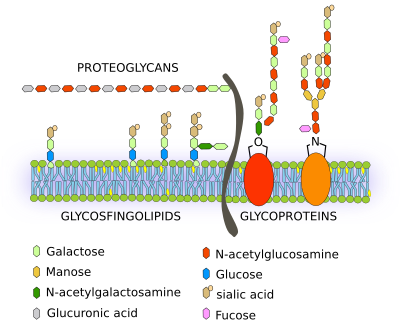Carbohydrates In The Plasma Membrane
Membrane carbohydrates are chemically leap to glycolipids and glycoproteins. However, some membrane carbohydrates are part of proteoglycans that insert their amino acid chain amid the lipid fatty acids. Although some carbohydrates can be establish associated to intracellular membranes, most of them are located in the outer monolayer of the plasma membrane, facing the extracellular space (Figure 1). The synthesis of membrane carbohydrates starts in the endoplasmic reticulum, but it is in the Golgi complex where they are modified and grow by adding many new monomers to form circuitous carbohydrate molecules.

Three types of glycolipids are establish in membranes: glycosphingolipids, which are the nearly abundant in the creature cells, glycoglycerolipids, and glycophosphatidylinositol. Glycoglycerolipids are more frequent in the plasma membrane of plant cells. However, most of the membrane carbohydrates are institute linked to proteins, known equally glycoproteins. Nearly all the membrane proteins have carbohydrates, simply but 5 % of lipids are glycolipids. Carbohydrates of the plasma membrane as a whole are referred as glycocalyx. In some prison cell types, glycocalyx is so developed that can be observed with the electron microscope. For example, in erythrocytes, the glycocalyx can be extended more than 1 µm in length from the plasma surface. In this manner, the cell is covered past a coat of carbohydrates that can be upwards two to 10 % of the membrane weight. The glycocalyx development depends on the cell type.
Membrane carbohydrates perform two main functions: participate in prison cell recognition and adhesion, either prison cell-prison cell signalling or prison cell-pathogen interactions, and they have a structural role as physical barrier. For instance, blood groups are determined by jail cell surface carbohydrates of erythrocytes, and they besides have the power to trigger immunological responses. Later on an infection, endothelial cells nigh the injured tissue betrayal a type of proteins, known as selectins, in their plasma membranes. They recognize and bind carbohydrates of the plasma membrane of lymphocytes that get through the bloodstream. In this fashion, lymphocytes go attached to the blood vessel walls, can cross the endothelium and movement to the infection focus. Carbohydrates as recognition molecules are also important during embryonic development.
Carbohydrates of the plasma membrane are major recognition and attaching sites for pathogens during infection. Virus, such as the influenza virus, pathogenic Due east. coli bacteria, and some protozoa need to be attached to the cell surface earlier inbound the cell, otherwise they will be swept by the cleaning mechanisms of the trunk. These pathogens accept proteins, known as lectins, that bind to specific carbohydrates of particular cells. Thus, the type of prison cell to be infected depends on the carbohydrates they show in the plasma membrane. Vertebrates, invertebrates and protozoa acquit dissimilar set up of carbohydrates in their cells. Curiously, some pathogens are able to "dress" superficial carbohydrates like to those of the host cells. In this way, they cannot exist detected. In that location are differences in the saccharide composition of cells of vertebrate, invertebrate and protozoa.
Bibliography
Fuster MM, Esko JD . The sweet and sour of cancer: glycans as novel therapeutic targets. Nature reviews cancer. 2005. 5(7):526-542.
Carbohydrates In The Plasma Membrane,
Source: https://mmegias.webs.uvigo.es/02-english/5-celulas/3-glucidos.php
Posted by: cartwrightpospot.blogspot.com


0 Response to "Carbohydrates In The Plasma Membrane"
Post a Comment